- Islam & the Imagination: Notes from an American Artist in the 21st Century

- Aquí y Allá: The Tower of the Antilles by Achy Obejas
Dérives Versus Derivatives: the Future/s Value of The Underline
Felice Grodin
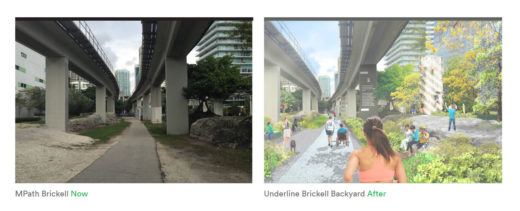

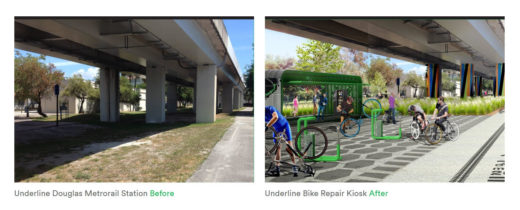
I remember an article by Hito Steyerl – “How Kill To People: A Problem of Design.” She writes about the notion of creative destruction and how accelerated capitalism dissolves and absorbs all things. This recalls Gilles Deleuze and Félix Guattari’s notion of axiomatic reterritorialization otherwise known as the capitalist death drive. Steyerl proposes to imagine design as a ‘reverse bulldozer,’ digitally wiping before and after scenes of urban development to tidy up the messiness of the ghosts of the past. “The video uses wipes to transition from one state to another, from present to future, from elected municipality to emerging rule, from working class neighborhood to prime real estate. Wipes as a filmic means are a powerful political symbol. They show displacement by erasure, or more precisely replacement. They clear one image by showing in another and pushing the old one out of sight.” So what is the before that the after is “pushing out” in the case of The Underline? Is the project simply augmenting a banal and underutilized piece of land? As I gaze at the various images of the extended site, what becomes evident is the grafting of transportational infrastructure in Miami. The Metrorail appears as a gigantic centipede snaking its way through the urban tissue of the city. Looking up downtown Miami on Google Earth, I notice that at certain elevations the Metrorail overlays onto the city grid and at others it congeals and fuses with various tethered veins of highway. This territorial network is of horizontal and stealth circuitry. Metrorail is thus analogous to an invasive species. Invasive species are nothing new to South Florida which attracts them more than any other part of the United States. Therefore a fitting creature for the Metrorail might be the Burmese python which leverages existing ecosystems for its own efficiency and advantage. And like a thin veneer that separates above and below, our sea level is its datum. The recently completed tunnel, nicknamed ‘Harriet’, serpentines under Government Cut connecting the PortMiami via the MacArthur Causeway to I-95. On any given day one can sit in the sculpted plaza sandwiched between the Pérez Art Museum Miami and the Phillip and Patricia Frost Museum of Science and observe the frequency of emerging shipping containers transported by trucks. The ebbs and flows of goods are heavily trafficked on our landscape, but we rarely notice. In another case,transportational infrastructure is both an urban cause and effect. One such case in Miami is Overtown. Overtown was developed to house the labor force that built the original Florida East Coast Railway. But by 1965 the implementation of Interstate 95, the East-West Dolphin Expressway and later Metrorail, had supplanted large areas of Overtown. Yet Overtown also utilizes public transit. According to “Metro Atlantic: Architecture, cities, transit and urbanism,” the Overtown Metrorail station is the fastest growing in Miami since 2007 by 84%. If The Underline is a new urban concept that laminates onto the old, can infrastructure be something that, despite decoupled planning restrictions, have an emancipatory potential beyond these limits?
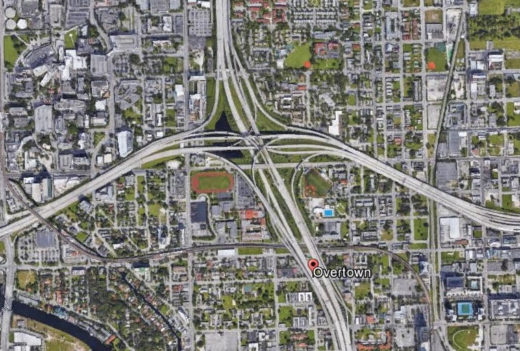
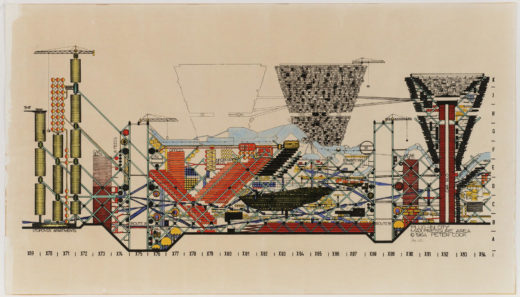
Archigram’s 1964 Plug-In City
If then, as Easterling points out, “entrepreneurs design not only the product but also its passage through a market,” why can’t art have a similar approach to utilizing infrastructure? And why not view infrastructure as an artistic medium? The recent inaugural commission by the Miami-Dade County’s Department of Cultural Affairs program Art in Public Places of four distinct art interventions are full of such promise, especially with consideration to the future. Rather than viewing these interventions as “contemporary art,” is it not more useful to consider them as valves? Valves are another Easterling-like operation that “may generate effects some distance down the road or the line.” Contingencies may be factored in that produce unintended results. Like prototypes that are tactically inserted into a system, they metrically bend to that system, and the system itself is thereby bent creating a mutation.
So what if we forecast these future forms beyond The Underline renderings of today? As artist Diann Bauer recently wrote in her essay You Promised Me Primer and You Gave Me Gossip Girl, “We can see this in derivatives markets, where the agreement to buy or sell an asset in the future at a certain price effects how that thing is traded in fact today. This projected future takes on a truth value because it effects things in the present…it doesn’t matter if that future actually comes to pass or not, because it has already had its moment of truth by altering the present…”
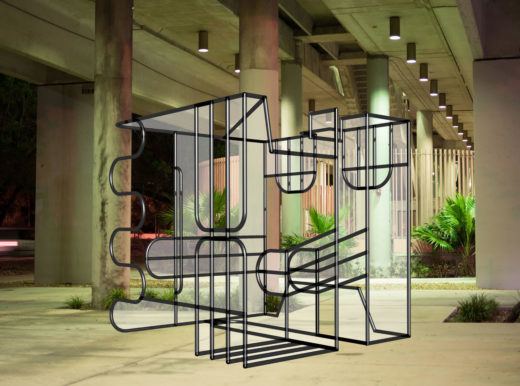
Rendering of Nick Lobo’s The Brutal Workout
I believe in The Underline. I believe in the value that art programming may bring to it. But I’ll bet on its future. Or, perhaps better said, I believe in the capacity of its future(s) potential, and how it may traverse time to transform our present.
Felice Grodin is an artist with a background in architecture. Her practice is focused on alternative landscapes that span both the micro and macro scale.








